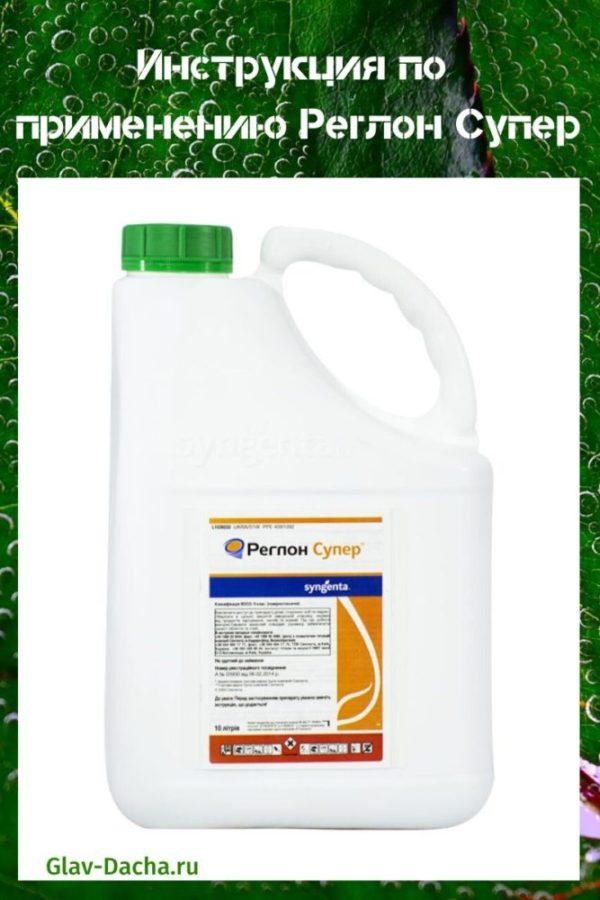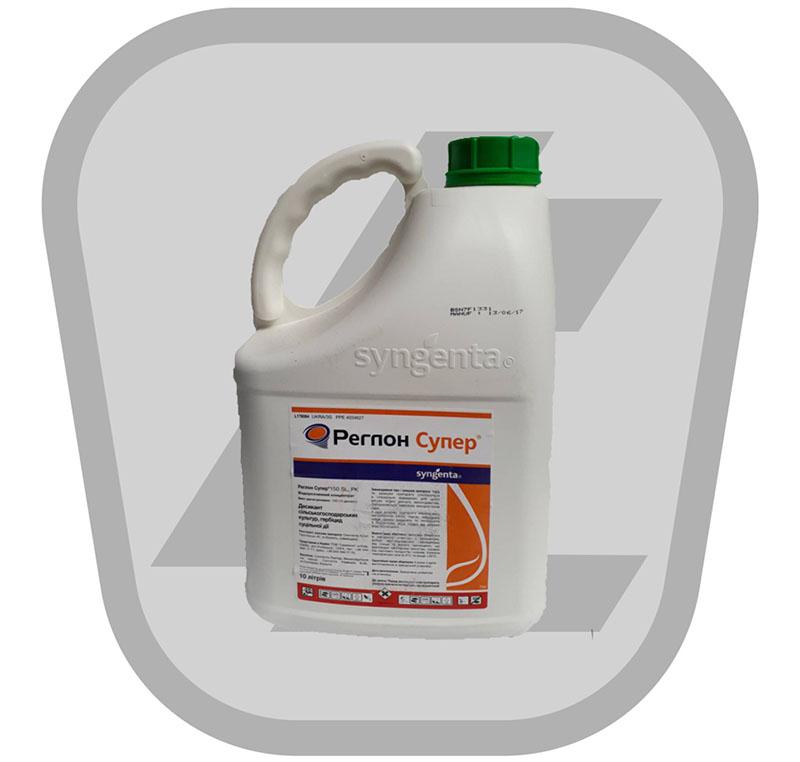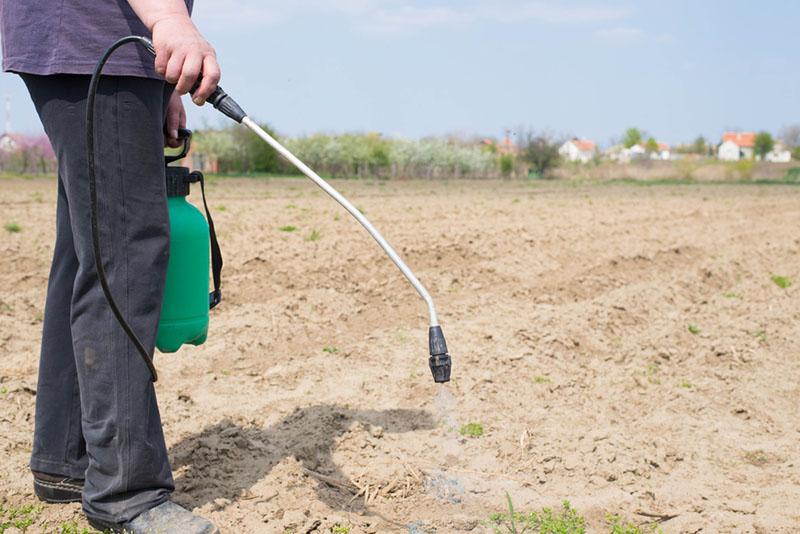Instructions for use Reglon Super
 Instructions for use Reglon Super contains information that the drug is a contact pre-emergence herbicide and belongs to desiccants. Treating the site before harvesting can dry out the plants, make harvesting easier and reduce the amount of weed seeds in the soil.
Instructions for use Reglon Super contains information that the drug is a contact pre-emergence herbicide and belongs to desiccants. Treating the site before harvesting can dry out the plants, make harvesting easier and reduce the amount of weed seeds in the soil.
Reglon Super also helps to reduce the risk of developing diseases of agricultural crops, for example, gray rot, sclerotinosis, phomopsis.
Release form and composition

The active component of the drug is diquat dibromide - an organic salt. If this salt is dissolved in water, it will decompose into positively and negatively charged ions. The action of positively charged diquat ions is aimed at desiccation, they are the active part of diquat dibromide.
Operating principle
 Desiccant Reglon Super is very quickly absorbed by the plant when it hits its surface. As a result, the cellular structure of the green parts is destroyed, they lose moisture, and the culture matures much faster. This allows you to control the time of harvesting, to achieve its simultaneous ripening. At the same time, weed grass is also dried, so that it does not interfere with the process of mechanized harvesting.
Desiccant Reglon Super is very quickly absorbed by the plant when it hits its surface. As a result, the cellular structure of the green parts is destroyed, they lose moisture, and the culture matures much faster. This allows you to control the time of harvesting, to achieve its simultaneous ripening. At the same time, weed grass is also dried, so that it does not interfere with the process of mechanized harvesting.
Due to the ability to remove moisture, the preparation can be used to treat seeds in order to reduce the cost of drying them.
After the treatment of seeds and plants, the herbicide substances are quickly eliminated, so it does not harm either seeds, plants or people.
Appointment
Application of Reglon Super allows you to get excellent results when processing the following crops:
- fodder, table and sugar beets (seed crops);
- grain crops;
- peas;
- potatoes;
- cabbage (seed crops);
- bow;
- rice;
- linen;
- radish (seed crops);
- carrots (seed crops);
- alfalfa (seed crops);
- sunflower;
- hop;
- turnips (seed crops);
- sorghum (seed crops);
- soy;
- ardent and winter rapeseed.
Benefits
In the description of Reglon Super, the manufacturer highlights the following advantages of the drug:
- Allows the entire crop to ripen quickly at the same time. Thanks to this, it is possible to carry out cleaning at the scheduled time, regardless of the temperature and humidity.
- It is the fastest-acting desiccant. Due to this, cleaning can be carried out a few days after its application.
- Reduces the moisture level of the seeds, which saves time and money on drying.
- Prevents significant seed loss during harvest.
- Increases the yield of planting material, as well as its quality.
- By drying the weeds, it facilitates the harvesting process.
- Provides protection against crop diseases.
Instructions for use Reglon Super
 Use clean water to prepare the working solution!
Use clean water to prepare the working solution!
Fill the sprayer tank with water, filling it halfway, and activate the agitator. Then add the required amount of Reglon Super and, without stopping stirring, continue to pour water into the tank.
The consumption of the working fluid for each crop is different. Therefore, the method of its preparation must be found in the Reglon Super instructions for use. On average, 200-300 liters of ready-made solution is required to process a plot of 1 hectare, but in some cases it is enough to add 50-100 liters per 1 hectare.
The shelf life of the prepared solution does not exceed 24 hours. After the specified time has passed, it cannot be used.
Desiccation is recommended in the evening or in cloudy weather.
Rain, which started 10 minutes after treatment, does not reduce the effectiveness of the herbicide, so re-spraying is not required in this case.
Consumption for different crops

The consumption rate of Reglon Super, the phase of application of the drug and the waiting period depends on the type of culture.
- Sunflower. Spraying is carried out when the roots are browned, 2-3 liters of the drug are used per 1 hectare.
- Peas are processed after yellowing of the lower pods with a grain moisture content of less than 45%. For 1 hectare, 2-3 liters of solution are used.
- Cereal crops are sprayed 2 weeks before harvest, with grain moisture up to 30%. The application rate is 1.5-2 liters per hectare.
- Alfalfa is processed after 85-90% of the beans have been browned. On a plot of 1 ha, 3 liters of the drug are used.
- Carrots are sprayed after the seeds are fully ripe in umbrellas with a moisture content of the total mass of seeds up to 50%. The application rate per 1 ha is 2.5-3 liters, the waiting period is 5-10 days;
- rice is processed after the plants are fully ripe 5 days before harvest. 2 liters of herbicide are used per hectare, the result becomes noticeable after 5 days.
- Flax is treated at the early yellow maturity of plants. For 1 hectare, 2-3 liters of the composition are used, the waiting period is 10 days;
- Rapeseed is sprayed when 70% of the pods are brown. 1 hectare of land requires from 2 to 3 liters of solution.
- Soybeans are sprayed in the phase when the beans of the lower layers of plants become brown. Consumption - 2-3 liters per 1 ha, the result becomes noticeable after 6 days;
- Beets are processed after browning 30-40% of the glomeruli, 4-6 liters of herbicide are used per hectare. The waiting period for sugar beet is 10 days, and for feed and canteen it is 8 days.
- The radish requires spraying once the seeds are waxy. For 1 hectare, 4-5 liters of solution are used, the result appears after 10 days.
- Pods when the seeds of the lower beans turn yellow, while the seed scar should be black. The consumption rate is 4-5 liters, the waiting period is 10 days.
- Cabbage is processed during biological maturity. A plot of 1 hectare requires 2-3 liters of herbicide.
- Potatoes are sprayed 10 days before harvesting, 1.5-2 liters are used per hectare.
Control of cereals
 Instructions for use Reglon Super indicates the possibility of using the drug for processing cereals.
Instructions for use Reglon Super indicates the possibility of using the drug for processing cereals.
The cultures listed above are processed for desiccation. Spraying of onions and hops is carried out to combat annual and perennial cereal and dicotyledonous weeds:
- Hops are processed at a plant height of 4-5 cm, 1.5-2 liters of the preparation are consumed per hectare. The waiting period is ―7 days.
- The onions are sprayed before the first shoots appear. 2-4 liters of herbicide are used per hectare. There is no waiting period for onions.
The recommended consumption rate of the prepared solution is from 250 to 400 liters per hectare.
The consumption rate depends on the degree of leafiness of the plant, the number of weeds, the level of humidity in the air, as well as the need to harvest in a short time.
The instructions for use of Reglon Super indicate that the drug belongs to the 2nd class of hazard for mammals.
It is necessary to use this product, strictly adhering to the manufacturer's recommendations, taking into account the restrictions for sanitary zones and reservoirs with fish.
Compatibility with other drugs
The herbicide can be combined in tank mixtures with ammonium nitrate and urea. When processing potatoes, it is allowed to use simultaneously the Reglon Super tank mixture and the Shirlan fungicide.
You should not combine this drug in tank mixtures with other pesticides, since the timing of their use does not coincide.